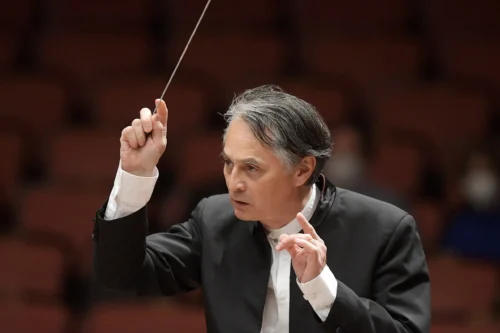 United States Bartók, Ravel: Leonidas Kavakos (violin), San Francisco Symphony / Jun Märkl (conductor). Davies Symphony Hall, San Francisco. 16.10.2025 (HS)
United States Bartók, Ravel: Leonidas Kavakos (violin), San Francisco Symphony / Jun Märkl (conductor). Davies Symphony Hall, San Francisco. 16.10.2025 (HS)
 Jun Märkl © Indianapolis Symphony.
Jun Märkl © Indianapolis Symphony.
Bartók – Violin Concerto No.2
Ravel – Daphnis et Chloé (complete)
I had never seen Jun Märkl conduct but knew of him as a fixture in European opera houses and the current music director of the Indianapolis Symphony and Taiwan National Symphony. At this matinee performance with the San Francisco Symphony, Märkl led impressive performances of Bartók’s Violin Concerto No.2 with Leonidas Kavakos as soloist and Ravel’s unabridged Daphnis et Chloé, which unfolded with blazing color and definition.
In his conducting, however, he never stopped cueing and gesturing which left me as exhausted as he must have been. Later, reading a program article about him (and another conductor making local debuts this month), I noted that Märkl named Seiji Ozawa as his prime mentor. That did not surprise me. His highly demonstrative style immediately reminded me of Ozawa, who was the music director for this ensemble when I moved to San Francisco in 1977.
Both pieces are highly energetic. The concerto bobs and weaves through contrasting episodes. A deceptively sweet lyrical opening turns to complexity in its second theme, which uses all 12 tones without forgoing tonality. At the end of the first movement, Bartók calls for microtones in the fiendishly difficult cadenza, and instructs the violins to snap the strings during a pizzicato sequence leading up to the ending.
Kavakos, in no way flamboyant in his gestures, applied glistening tone to the violin’s sound, enough to make the lyrical passages balance the crunchier dissonances in other episodes. The fiery bits, however, came off as matter-of-fact rather than dramatic. The theme-and-variation slow movement was better. The contemplative tune began with suppleness and gradually gained grit as the harmonies tightened into eeriness and, finally, out-and-out nastiness with a military march just before the end of the movement. The finale darted this way and that rhythmically, the music gaining ever more momentum, only stepping back as if to take a breath before a taut finish. The excitement came more from the orchestra than the soloist.
It has been two seasons since Esa-Pekka Salonen conducted a glorious Daphnis et Chloé, complete with Ravel’s original wordless chorus for extra texture. It is by far the composer’s most extensive piece at some 55 minutes, and most performances are of one of the many suites. No.2 of those (basically Part Three of the original ballet) has most of the best music and concludes with the explosively colorful Bacchanale.
It is hard to tell whether the orchestra’s experience of playing this piece so recently or Märkl’s hyperactive conducting was responsible for the cohesive and detailed performance this time around. Maybe both. Even without the chorus (a version authorized by Diaghilev, who produced the original ballet), the music seemed to reach a delightful high point every minute or so.
In Parts One and Two, the scenes of sensual activities on ancient Lesbos did not tingle with the most memorable music, though Märkl carefully shaped dynamics and almost constant shifts in tempo kept things interesting. The individual efforts of the orchestra’s principals produced some beautiful moments: the haunting low range of clarinetists Carey Bell and Steve Sanchez, the high range of oboist Eugene Izotov and the soulful spun-out lines from the English horn of Russ de Luna were especially appealing. Most impressive was flutist Yubeen Kim’s vivid and extraordinary sustained sound in the last section of Part Two, ‘Danse suppliante de Chloé’.
Part Three got off to a sultry start with pastel colors throughout the orchestra in Ravel’s gorgeous scene-painting of the dawn. Kim’s impersonation of Pan’s flute in ‘Les amours de Pan et Syrinx’ created bright light, and that led into the big finale, the Bacchanale. Here Märkl’s pacing and control of intensity brought the proceedings to a stimulating finish.
Harvey Steiman
